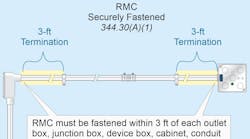Q. What is the Code rule for sizing the equipment grounding conductor for feeder taps, and can you give me an example?
A. Equipment grounding conductors for feeder taps must be sized in accordance with Table 250.122, based on the ampere rating of the overcurrent device ahead of the feeder. In no case is it required to be larger than the feeder tap conductors [250.122(G)].
Example: A 400A breaker protects a set of 500kcmil feeder conductors. There are three taps fed from the 500kcmil feeders that supply disconnects with 200A, 150A, and 30A overcurrent devices. What are the minimum size equipment grounding conductors for these taps?
The equipment grounding conductor, based on the 400A feeder protection, would be required to be 3 AWG by Table 250.122. However, 250.122(G) states that the equipment grounding conductor run with feeder taps is not required to be larger than the feeder tap conductors in each raceway.
• 200A: 3/0 AWG is rated 200A at 75°, and is greater than 10% of the ampacity of 500kcmil, which is rated 380A at 75°. The equipment grounding conductor would also be 3 AWG.
• 150A: 1/0 AWG is rated 150A at 75°, and is greater than 10% of the ampacity of 500kcmil, which is rated 380A at 75°. The equipment grounding conductor would also be 3 AWG.
• 30A: 8 AWG is rated 50A at 75°, and is greater than 10% of the ampacity of 500kcmil, which is rated 380A at 75°. Anything smaller than 8 AWG can’t be used, as it will have an ampacity of less than 10% of 380A (38A) in the 75° column of 310.15(B)(16). The equipment grounding conductor would be 8 AWG.



